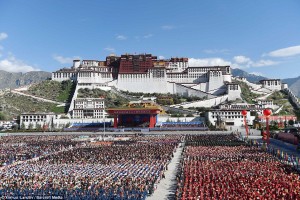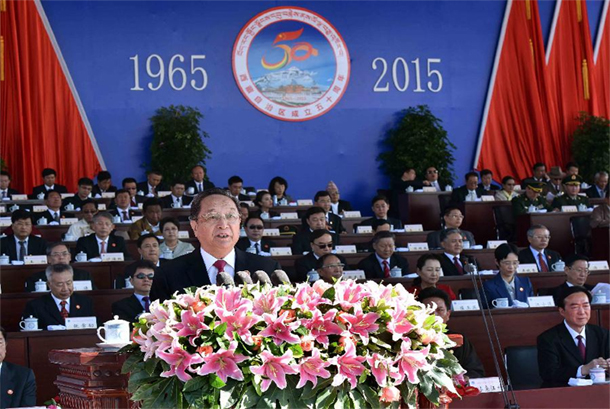Festivities and a large public parade have taken place in Lhasa this month to commemorate the 50th anniversary of Chinese occupation in the Tibet Autonomous Region. All events were organised and overseen by the Chinese Government, with regional unity and the increased welfare and happiness of the Tibetan community emphasised throughout.
The exiled Tibetan community have heavily criticised this event, dismissing it as Chinese propaganda used to push an unfounded image of a prospering, content and happy Tibetan community. According to Tenzing Jigme, President of the Tibetan Youth Congress in Dharamsala, “the case is that Tibetans are still being denied basic human rights – freedom of religion, freedom of speech, freedom of press and so we are totally against this kind of false celebration.”

A ceremony marking the 50th anniversary of the founding of the TAR is held in front of the Potala Palace, Lhasa
Photo: Xinhua
Photographs of the anniversary parade show Tibetan and Chinese people from all over the region standing in front of the Potala Palace, waving Chinese and commemorative 50th anniversary flags. Parade floats featured slogans such as “Forever following the Communist Party” and “Strengthen Ethnic Unity, Build Beautiful Tibet”, and were followed by Chinese marching bands and military troops.
Many Chinese officials were in attendance, including Yu Zhengsheng, a Standing Committee member in charge of ethnic and religious issues. Zhengsheng addressed the crowd on the need for ethnic groups to identify with Chinese nationality and the Communist Party, stating that “separatist” dissention in the form of protest and self-immolation would continue to be dealt with under Chinese law.

Zu Zhengsheng, chairman of the National Committee of the Chinese People’s Political Consultative Conference at the function
Photo: Xinhua
Chinese media outlets were flooded with articles on the anniversary festivities, lauding China’s occupation as a “great leap forward” for the Tibetan community, praising the superior economic and educational conditions in post-invasion Tibet. However, not all Chinese coverage followed the party line. The South China Morning Post published an article acknowledging the “far darker reality” of the anniversary, suggesting that the central government was “painting over the cracks” in the TAR with this event. The article went on to suggest that the government take a hard look at their own policies in order to address increasing protests and self-immolations from the Tibetan community, rather than using militant surveillance to enforce cultural and religious repression.
Whilst His Holiness the Dalai Lama has not commented publicly upon this event or the comments of the Chinese, Sikyong Dr. Lobsang Sangay gave a brief statement. ‘There is nothing to celebrate in Tibet. Tibet is still under occupation and Tibetans are still brutally repressed.’




 Print
Print Email
Email